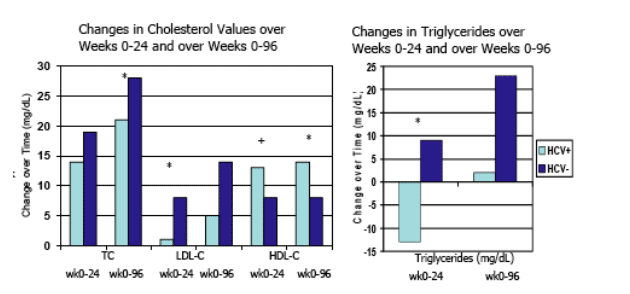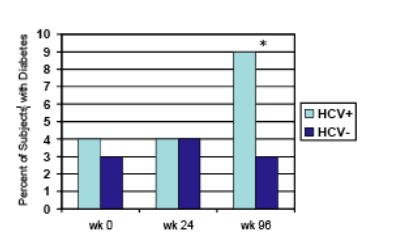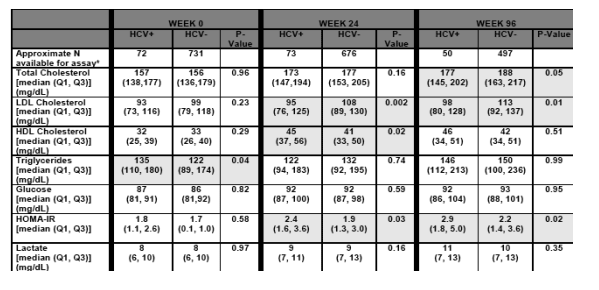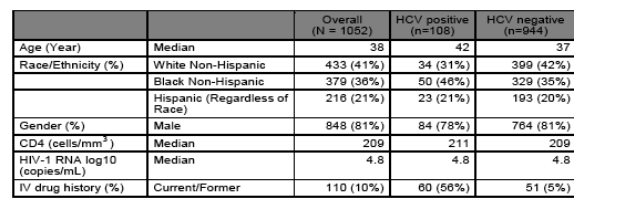 |
 |
 |
| |
The Effect of Hepatitis C Infection on Metabolic Parameters following Initial Therapy of HIV Infected Subjects with Nucleoside +/- NNRTI Regimens
|
| |
| |
Reported by Jules Levin
15th CROI, Feb 2008, Bostn
Cecilia M Shikuma*1, Heather J Ribaudo2, Evelyn Zheng2, Marshall J Glesby3, William A Meyer4, Karen T Tashima5, Barbara Bastow6, Daniel R Kuritzkes7, Roy M Gulick3, and AIDS Clinical Trials Group
A5095 Study Team 1 University of Hawaii, Honolulu, HI; 2 Harvard School of Public Health, Boston, MA; 3 Weill Medical College of Cornell University, New York, NY; 4 Quest Diagnostics, Baltimore, MD;
5 Brown University, Providence, RI; 6 Social & Scientific Systems Inc., Silver Spring, MD; 7 Brigham and Women's Hospital, Boston, MA
Several other studies have shown that HCV+ patients tend not to get increases in lipids as much as HIV-negatives. This could be because the liver isn't able to synthesize the lipids as well. My own personal experience was that my lipids levels shot through the roof, particularly cholesterol & triglycerides, after curing HCV. This suggested to me that my liver was now able to synthesize lipids but previously lipids levels were kept suppressed due to the HCV. My TG increased to over 1000 after curing HCV after being relatively low. And my cholesterol shot up to about 400 after curing HCV. Eventually I was able to reduce TG & cholesterol to normal levels.
AUTHOR BACKGROUND
HIV/hepatitis C (HCV)-co-infected individuals on highly active antiretroviral therapy (HAART) have been reported to have lower total and LDL cholesterol values than HIV mono-infected individuals [1-3]. Higher rates of diabetes, hyperglycemia and insulin resistance have also been reported in co-infected individuals [1, 4-6]. The specific role of antiretroviral regimens in the development of these differences as HIV/HCV coinfected individuals are placed on 1st time HAART have been less studied, particularly in PI-sparing regimens.
AUTHOR CONCLUSIONS
HCV co-infection modestly alters some metabolic parameters following NRTI +/- NNRTI ARV treatment. In particular, compared to HIV mono-infected individuals, NRTI+/- NNRTI ARV treatment in HCV/HIV co-infected individuals results in:
· Higher insulin resistance and rates of diabetes
· Lower levels of LDL-C values
· Higher increases in HDL-C values
The cardiovascular impact of these differences remains to be determined.
RESULTS: From Jules: increase in total cholesterol at week 96 was statistically greater in HCV- vs HCV+ (21% increase vs 26%). LDL increased 7% in HCV- vs 1% in HCV+ at week 24; at week 96 LDL increased 5% in HCV+ vs 14% in HCV-negatives. Triglycerides in where you see the biggest difference. At week 24 TG decline 13% in HCV+ and increase 8% in HCV-. At week 96, TG increase 22% in HCV- and increase 2% in HCV+.
As shown in Table to right, rates of diabetes (fasting blood glucose >
126 mg/dL) were similar at baseline and at week 24. However at
week 96, a greater proportion of HCV+ compared to HCV- subjects
had diabetes (9% vs 3%) (* p=0.03). Relative risk for incidence of diabetes in
HCV+ vs HCV- (unadjusted for other variables): wk 24 [RR 1.05, 95%
CI 0.3, 3.5, p=0.94], wk 96 [RR 3.49, 95% CI 1.4, 8.6, p=0.01].
No differences between HCV+ and HCV- groups were noted in change
in plasma glucose levels between wk 0-24 or between wk 0-96.
However, there was some evidence of a higher increase in log[HOMA
IR] in the HCV+ group in the wk 0-24 assessment (p=0.02).
ABSTRACT
Background: Limited information is available on the impact of hepatitis C (HCV) co-infection on metabolic changes in HIV subjects starting initial nucleoside +/- non-nucleoside reverse transcriptase inhibitor (NNRTI) antiretroviral (ARV) therapy. We assessed fasting metabolic parameters in subjects with and without HCV antibody following initiation of such therapy in an AIDS Clinical Trials Group clinical trial.
Methods: Analyses involved 78 HCV-antibody positive (HCV+) and 760 HCV-antibody negative (HCV-) subjects in A5095, a study of initial treatment of HIV infection with a triple-nucleoside [ZDV/3TC/ABC], 3-drug efavirenz (EFV) [ZDV/3TC+EFV], or 4-drug EFV [ZDV/3TC/ABC+EFV] regimen. Fasting metabolic parameters [total, HDL and LDL cholesterol (C), lactate, triglyceride (TG), glucose, and insulin with calculation of HOMA-IR] were assessed at week 0, 24, and 96. The distribution of metabolic parameters at each week and their changes from baseline (week 0-24 and week 0-96) were compared by Wilcoxon test between HCV+ and HCV- subjects.
Results:
At baseline, all metabolic parameters were similar except for slightly higher TG in
HCV+ subjects [HCV+ vs HCV-(median): 135 vs 122 mg/dL, p=0.04]. Numbers of HCV+ subjects were equal across arms.
Following therapy, HOMA-IR levels were modestly higher and LDL-C levels were modestly lower in the HCV+ compared to HCV- subjects at both week 24
[HCV+ vs HCV- (median): HOMA-IR 2.41 vs 1.92, p=0.03; LDL-C (mg/dL) 95 vs 108, p=0.002] and week 96 [HCV+ vs HCV-(median): HOMA-IR 2.89 vs 2.16, p=0.017; LDL-C (mg/dL) 98 vs 113, p=0.012].
Rates of diabetes (fasting glucose > 126 mg/dL) were similar at baseline;
however at week 96, a greater proportion of HCV+ compared to HCV- subjects had diabetes (9% vs.3%, p=0.03).
While differences were modest, changes from week 0-24 showed greater
increases in HDL-C and in HOMA-IR and smaller increases in LDL-C and TG in HCV+ compared to HCV- subjects (all p< 0.05); similar trends were apparent in the week 0-96 changes but only HDL-C remained statistically significant (p=0.02).
No differences in lactates were found either in distribution at the assessed timepoints or in change over time.
Conclusions: HCV co-infection modestly alters some metabolic parameters following NRTI +/- NNRTI ARV treatment. In particular, HCV co-infection results in higher insulin resistance and rates of diabetes, and lower LDL-C values. The cardiovascular impact of these differences remains to be determined.
RESULTS
A5095 Change in Cholesterol and Triglyceride Parameters in HCV+ vs HCV- Subjects over Weeks 0-24 and over Weeks 0-96
Some modest but statistically significant differences in the degree of change in some lipid parameters (TC, LDL-C, HDL-C, and TG) were noted between the HCV+ and HCV- groups [*p<0.05; + p=0.001]. Most of the differences were noted between week 0 and 24. Greater increases in HDL-C were noted in the HCV+ group for both wk 0-24 and wk 0-96 changes.
From Jules: increase in total cholesterol at week 96 was statistically greater in HCV- vs HCV+ (21% increase vs 26%). LDL increased 7% in HCV- vs 1% in HCV+ at week 24; at week 96 LDL increased 5% in HCV+ vs 14% in HCV-.
Triglycerides in where you see the biggest difference. At week 24 TG decline 13% in HCV+ and increase 8% in HCV-. At week 96, TG increase 22% in HCV- and increase 2% in HCV+.

n for wk 0-24 lipid changes: 67 HCV+ and 655 HCV- subjects; n for wk 0-96 lipid changes: 48 HCV+ and 483 HCV- subjects
Rates of Diabetes (fasting Blood Glucose > 126 mg/dL) and Changes in Fasting Glucose and HOMA-IR in HCV+ vs HCV- Subjects
As shown in Table to right, rates of diabetes (fasting blood glucose >
126 mg/dL) were similar at baseline and at week 24. However at
week 96, a greater proportion of HCV+ compared to HCV- subjects
had diabetes (9% vs 3%) (* p=0.03). Relative risk for incidence of diabetes in
HCV+ vs HCV- (unadjusted for other variables): wk 24 [RR 1.05, 95%
CI 0.3, 3.5, p=0.94], wk 96 [RR 3.49, 95% CI 1.4, 8.6, p=0.01].
No differences between HCV+ and HCV- groups were noted in change
in plasma glucose levels between wk 0-24 or between wk 0-96.
However, there was some evidence of a higher increase in log[HOMA
IR] in the HCV+ group in the wk 0-24 assessment (p=0.02).

A5095 Metabolic Parameters in HCV+ vs HCV- Subjects at Weeks 0, 24 and 96.
Lower levels of LDL Cholesterol and higher levels of HOMA-IR were noted in the HCV+ group compared to the HCV- group at both week 24 and week 96.

A5095 Baseline Characteristics of Cohort
Numbers of HCV+ subjects were equally distributed across the A5095 arms. Differences between HCV+ and HCV- groups were detected in age and IV drug history (p<0.001).

METHODS
·A5095 was a randomized, placebo-controlled, double-blind study designed to compare the following 3 NRTI +/- NNRTI containing ARV regimens for the initial treatment of HIV-1 infection:
·ZDV/3TC/ABC (coformulated) [Trizivir; GlaxoSmithKline]
·ZDV/3TC (coformulated) [Combivir; GlaxoSmithKline] plus EFV [Sustiva; Bristol-Myers Squibb] and
·ZDV/3TC/ABC (coformulated) plus EFV
The triple-nucleoside arm (ZDV/3TC/ABC) of ACTG study A5095 was discontinued early because of virologic inferiority following recommendation by the study's Data and Safety Monitoring Board. Some subjects on this arm enrolled into an amended study randomizing subjects to the addition of EFV or tenofovir (TDF) to the original triple-nucleoside regimen.
·This intent-to-treat metabolic analyses included all 1052 subjects of all arms from A5095 who had an evaluable hepatitis C (HCV) antibody test. Subjects without an HCV test or with results that were indeterminate were excluded (n=95). Missing data were ignored and no adjustments were made for treatment arms or lipid lowering agents. Fasting metabolic measures were compared between HCV antibody positive and HCV antibody negative subjects at week 0, week 24, and week 96. The absolute change from baseline to week 24 and to week 96 for each parameter were also assessed.
Metabolic measures assessed were:
·Total, LDL and HDL Cholesterol
·Triglycerides
·Glucose and HOMA-IR
·Lactate
·Fasting was defined as nothing by mouth except water and medications for a minimum of 8 hours before the blood draw.
·Wilcoxon tests for continuous variables and Fisher's exact test for categorical variables were used to compare differences between HCV+ and HCV- groups at weeks 0, 24 and 96 and changes from weeks 0-24 and from weeks 0-96. No adjustments were made for multiple comparisons; marginally significant p-values should be considered cautiously.
|
| |
|
 |
 |
|
|